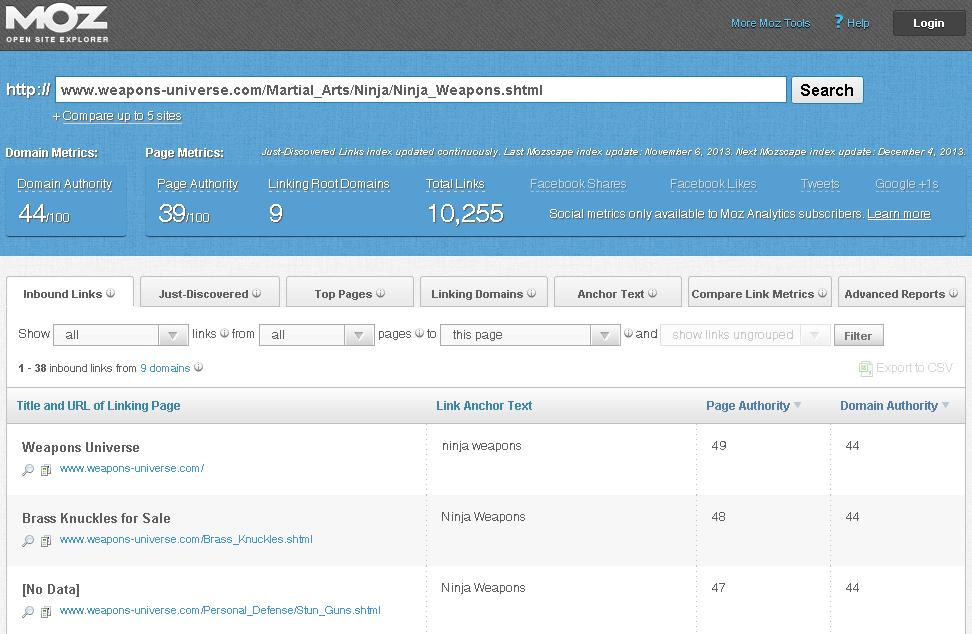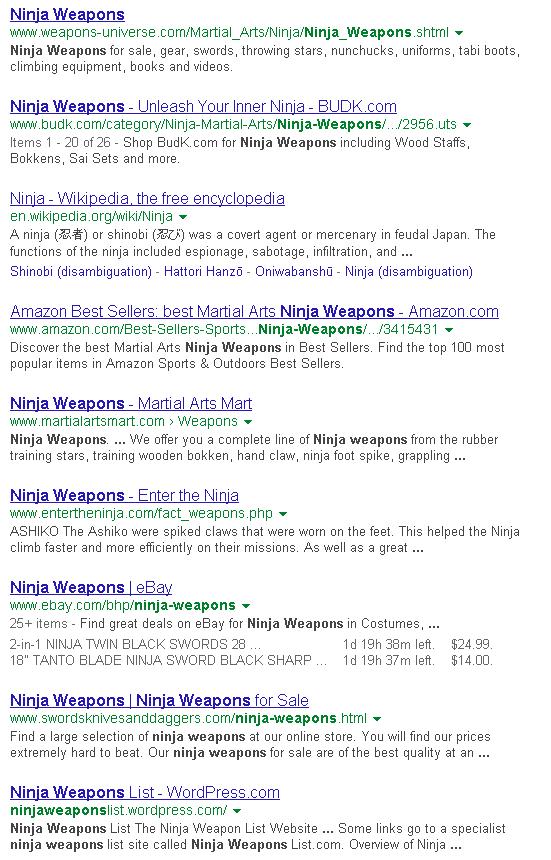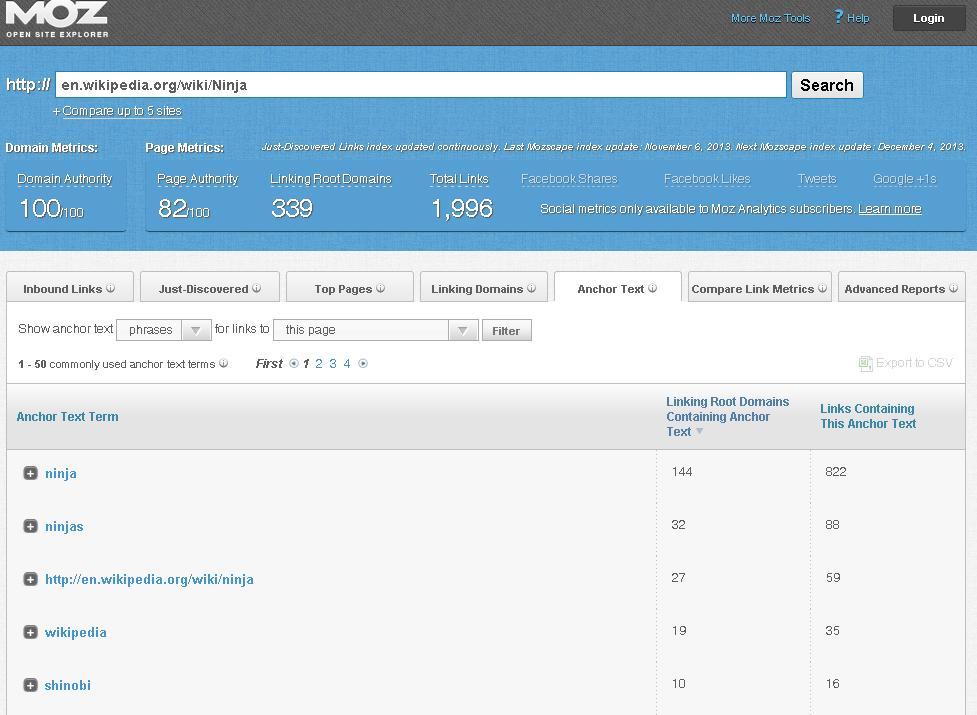Last Friday, I laid out what I feel is a pretty comprehensive guide to keyword research — the process, the tools, and the goals. Today, we’re talking about the natural partner to keyword research: competition analysis. This is the process of looking at what your client’s competition is doing with their keywords and their SEO. Competition analysis has two major purposes: first, it can help you find the keywords that are scoring big for them, and how they’re ranking for those keywords. Second, it can help you find market segments that your competition isn’t targeting, which should be easy for you to poach.
The Law of Competition and Volume
I probably should have covered this last week when we discussed keyword research, but it seems so basic to me that it just never occurred to me to mention it. The Law of Competition and Volume simply says “The more search volume a keyword gets, the more competition it has — and exceptions to this rule exist to be exploited by marketers like you.”
In other words, the whole point of keyword research and competition analysis is to find keywords that bring the money but don’t require as much effort (translation: money) to rank for. You’re searching a massive field of keywords that mostly follow the rule, looking for exceptions. That’s why this entire endeavor is so important — if you just pick relevant-sounding keywords at random, you’re not ‘cheating the system’, and someone who is will walk all over you on the way to the top spots.
There is a flipside to this rule, though — there are also exceptions in the other direction: keywords that seem to have a low volume but offer surprisingly stiff competition. Keep that in mind as we talk about…
How Competition Analysis Helps
The entire purpose of competition analysis is twofold. First, it can shortcut a lot of your SEO efforts — for example, you can look at what websites they’re getting backlinks from and go get backlinks from those same websites. You can see what anchor text they’re choosing for those backlinks, which will give you a good idea of the other keywords they’re hunting down.
That said, the biggest part of why competition analysis is so powerful is that aforementioned flipside: analysis will keep you from wasting a whole bunch of time and effort pursuing keywords that are low volume but offer unexpectedly tough competition.
There are several metrics you should be looking at when you do competition analysis, each for its own reason. Here’s a breakdown:
Domain Authority
Domain authority is one of those things that most people give up on right off, because they compare themselves to Wikipedia, About.com, and other super-sites. There is a kind of logic to that; if you see these kids of sites in the top sites of your chosen keyword, it’s not likely that you’re going to knock them off easily. On the other hand, domain authority is only one ranking signal, and if you can displace them and net one of the top spots using non-Domain Authority ranking signals, chances are they’re not going to take the top site back from you anytime soon.
Incoming Links
Google claims they examine more than 200 factors when ranking a website, but powerful analysts like Moz and Search Engine Watch have proven repeatedly that the most significant ranking signal is “number of unique root domains that have sites linking to your page.” So much so that there are SEO companies out there who specialize in unique root domain links to the exclusion of almost everything else.
If you’re doing competition analysis and you come across a page on a fairly innocent keyword that has a hundred backlinks from 80 different unique root domains, you know you’re going to have to bust your butt a little in order to get above that page in the SERPs.
Domain Age/Freshness
Lots of people talk about ‘freshness’ being beneficial to your SERPs, but they don’t tell you that ‘fresh’ only lasts about 2 weeks unless you draw some powerful social shares and likes. Once ‘fresh’ passes on, domain age takes over, and older domains get preferential treatment over newer ones. This leads some entrepreneurs desperate for every advantage to purchase old, parked domains and turn them into new ones, but honestly that seems excessive and unnecessary to me. The ‘freshness’ thing will only rarely come up during competition analysis, but if you do come across a website that’s less than two weeks old peaking out your SERPs, keep an eye on it and come back later — it’ll either be gone, or it will have settled in, at which point you need to do the whole analysis all over again to get the non-freshness signals.
Quality of Content
This is pretty straightforward — not only does Google have some pretty strict ‘guidelines’ about the quality of your content in their Penguin ruleset, but quality content gets more readers, which means Google wants it closer to the top of the SERPs in the first place. When you’re talking about competition analysis, you should go out of your way to look for instances of low quality content showing up early in the SERPs — it means that there’s an opportunity there for someone who comes in swinging high-end content around to step in and gather some ‘easy’ traffic.
An Example of Competition Analysis in Action
So, I Googled ‘Ninja Weapons’, and this is what I got. Let’s take a quick look at these. Head on over to Open Site Explorer and plug in the URL from that first link. Here’s what you get:

The first metric: domain authority. OSE gives this one 44/100; that’s fairly decent but not overwhelming.
As to incoming links, OSE tells us that there are only 9 unique root domains linking to this page, but 10,255 links. A click to a different tab within OSE lays that out: 10,242 of those links are internal, meaning that this page only has a whopping 13 links, from a total of 8 domains. This should be relatively easy to beat, especially considering that some of those domains (outlinersoftware.com, runicgames.com, natashalarrybooks.com/) aren’t particularly relevant to the subject matter at hand.
Domain age-wise, I use Webconfs domain age checker, which tells me that weapons-universe is 4 years and 0 months old. That’s pretty decent, but it’s definitely not an insurmountable advantage.
Then, we look at content. I’m not going to screenshot their content here, because it’s fairly extensive — and I can see why, given the market, weapons-universe has the top spot. Their content is excellent compared to other weapons stores; they have about a 350 word ‘article’ about ninja and their weaponry, followed by dozens of typical catalog-style listings of weapons, and then they follow that up with a long “ninja glossary” that includes some pretty unique terms (who knew that a ‘Bakuhatsugama’ was ‘a short-handled kusarigama with a container of explosives, poison, or blinding powder’?)
Now, before we move on, let’s take a real quick look at that Wikipedia link for comparison purposes:
Immediately, you see that Wikipedia has literally perfect domain authority, and even the page authority for this page is very very high. There are also 330 more unique root domains linking to this page than there were to the weapons-universe page, and Wikipedia is certainly more than four years old. So why does weapons-universe get the nod for #1 in the SERPs when Wikipedia seems to be so much better?
Simple: anchor text. Look at the anchor texts listed in that picture — zero of them are “ninja weapons”. The fact that Wikipedia managed to net third place despite it’s less-relevant anchor text should tell you two things here: one, anchor text is very important; and two, it’s still able to be overcome by enough other powerful ranking signals.
All told, looking at just at the #1 and #3 spots in the SERPs, I think it’s safe to conclude that “ninja weapons” is a keyword that’s not going to be terribly difficult to take over.
I don’t want to keep strumming the same strings, but it’s worthy of note that this research process is still fairly slow. If you purchase Market Samurai — and notice I’m not giving affiliate links or anything, this is just purely a straight-up genuine referral — you can get all of this information collated nicely in a matter of moments.
Taking It To the Next Level: Content Analysis
So, now you’ve got a fairly decent grip on what your competition has in terms of backlinks and SEO ranking factors — but that’s only a part of their story. You should also, if you’re planning on competing with these fellows in the long term, be doing a content analysis of their website as well. That breaks down into three rough steps: finding their content, tallying their content, and assessing their content.
Finding their content
Content comes in a lot of forms.
- Blog posts
- Articles
- White papers
- Videos
- Podcasts
- Slideshows
- eBooks
- Webinars
- Email courses
- Infographics
- Cartoons
- Press releases
- Case studies
- Data sheets
- FAQs
- Prezis
- Slideshows
- Actual web content
- And possibly many more forms
The first thing you have to do when you start analyzing a competing page’s content is find all of it — which is generally, unfortunately, a matter of investigating their website thoroughly. If they’re conscientious webmasters and have a complete site map, you should have no trouble finding 80%+ of it — obviously some of it, like the contents of an eBook they have for sale, you won’t get by just clicking about.
How far you want to pursue that is up to you. Just keep in mind that unless you’re designing a product to compete directly with theirs, you probably don’t need to look at their end product — it’s the stuff they’re using to attract attention, social media activity, and ultimately traffic that you’re interested in.
Tallying their content
This part can take a little time, because you need to establish their sechedule for publishing new content. It’s not unusual, for example, for a single site to whip up 3 blog posts, a podcast, an article, and either a white paper, a video, or an infographic each week — and you need to know all of that in order to know what kind of content pacing you’re going to have to match to keep up.
Some content forms, like blog posts, often come dated so it’s easy to see the schedule as it goes forward. Others, you’re just going to have to watch for a month or so and see when — and if — they have a regular content creation schedule.
The key here is that you have to watch more than just their website — you’ll also need to regularly check their incoming links and see if there are any new ones. Quite often, websites don’t publish new content on their own site first; they’ll put it up as a guest post or even on their Squidoo lens or someplace bizarre like that first and then copy it onto their site once the link juice has been assimilated by Google. Nevertheless, it’s their content and you’ll want to keep track of it.
Assessing their content
Assessing the content your competition is creating is largely a matter of answering a fairly straight-forward set of questions:
- Is their content accurate and timely?
- Is their content free of spelling and grammatical errors?
- Is their content in-depth, or just scratching the surface?
- What is their voice? More specifically, do they write authoritatively, or conversationally, or with some specific and unique voice like “pimp-ass thug” or “valley girl”? Most sites will fall between the first two, but every once in a while you’ll come across someone with a unique voice, and you should always ask yourself why they chose that voice to write in.
- Do they prefer short-form (350-500 word) or long-form (2000+ word) content? Neither one is ‘better’; but if all of the sites in a niche are leaning one way, going the other can help you stand out.
- How well is their content structured? Do they use bullet points, subheaders, and other tools to organize their text easily?
- Who writes their content? Do they attribute everything to one author, or do they have multiple contributors? What else do those people do (social media snooping can give you a surprising amount of information on this tip.)
- Does their content have in-line advertisements, ‘gates’ that keep people from accessing it without logging in, or other obstacles? This again isn’t necessarily bad, but Google tends to give extra SEO credit to sites with free, easy-access content, so if they’re gating or whatnot, it can mean an easier time getting ranked for you.
Now, go to the social media accounts for your competitor and look at which pieces of content get the most responses. This is great information in terms of helping you structure your own content in the future — learn from your competitor’s successes so that you can skip straight to their level without having to make the same mistakes. (At the same time, you should be making a note of which social media the competition is moving in. It may be, for example, that there’s an opening on Pinterest or LinkedIn that none of your competition is working — that’s an opening for you.)
Applying Your Findings
There are two basic lessons that you can learn by examining your competition’s content. The first is “What are they doing that I could be doing?” This can give you ample inspiration for content that your audience will respond to, and that alone is worth the effort. But the real winner here is “What are they not doing that I could be doing?”.
It’s a lot harder to see a hole in their strategy than it is to see their strategy, but if you do happen to stumble on one — say, they have no Twitter account, or their product is getting social responses from stay-at-home moms and they’re marketing exclusively to two-income households — you have an immediate and powerful advantage, because you have access to a market segment that they’re passing by.
By combining your studies on their SEO with your investigation of their content strategies, you can get a firm grip on exactly what your competition is doing — and what opportunities they’re passing by as well. It’s easy to become second best by imitating what the best is doing. If you can take that next step and find what the best isn’t doing, you can leverage that into the top position that you’re really after.




Leave a Reply: